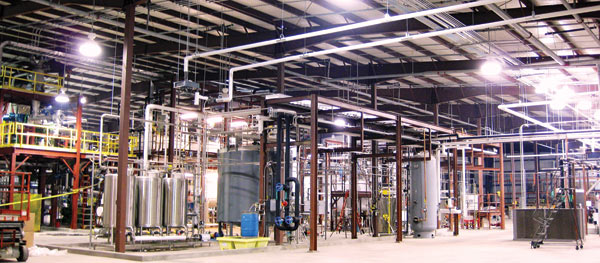When the biofuels startup Mascoma launched in 2005, it hoped to capitalize on technology that would produce ethanol from wood chips and other plant waste in an efficient one-step process.
Mascoma secured $30 million in financing by 2006 and began building a 200,000-gallon-per-year pilot plant in Rome, NY, the following year. In 2008, the company heralded new research advances toward genetically engineered bacteria that could thrive at high temperatures. Using them made it possible to reduce by 60 percent the quantity of costly enzymes needed to degrade cellulose into fermentable sugars. The company announced plans to build one of the first commercial-scale cellulosic-ethanol plants, in Kinross, MI; it would be able to produce 80 million gallons per year.
But as of the summer of 2010, Mascoma had yet to begin construction. Simply put, nobody would lend it the money for a production plant whose product would compete with relatively cheap oil. “The bottom line is, these are high-risk, first-of-kind plants,” says Mike Cleary, director of the National Bioenergy Center at the National Renewable Energy Laboratory in Golden, CO. “Getting banks to loan them money is hard.”
This story is only available to subscribers.
Don’t settle for half the story.
Get paywall-free access to technology news for the here and now.
Subscribe now
Already a subscriber?
Sign in
Mascoma received $49.5 million from the U.S. Department of Energy and the state of Michigan to finance its cellulosic-ethanol operations, and that funding has been earmarked for the Kinross plant. But Alan Belcher, Mascoma’s senior vice president of operations, says the company would need more than $100 million to build that facility.
A viable future for cellulosic ethanol will require changes in government policy, says Belcher. An existing federal mandate caps the amount of ethanol blended with gasoline in auto fuel at 10 percent of the total mixture. Existing production capacity for corn ethanol can already meet the resulting demand, which amounts to 13.5 billion gallons a year. Right now, there’s really no room for any more ethanol on the market, no matter how it’s produced. At the least, the blend limit must be raised; then a different set of federal mandates, dictating minimum use of advanced biofuels such as cellulosic ethanol, can kick in and provide a market for Mascoma’s product, Belcher says.
Mascoma currently hopes to break ground at Kinross in 2011. The goal is to begin production at 20 million gallons of ethanol per year, using 500,000 tons of hardwood pulpwood as feedstock. But to get there, great technology simply won’t be enough.
